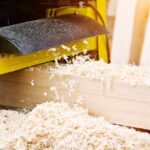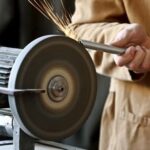Are you in search of a good table for woodworking? Look no further. Whether you are a beginner or an experienced woodworker, having the right table is essential for achieving quality results.
In this article, we will explore the various aspects of finding and creating a good table for woodworking that meets your needs and expectations. From choosing the right type of wood to considering design elements and durability, we will cover everything you need to know to make an informed decision.
When it comes to choosing the right wood for your woodworking table, there are several factors to consider. The type of wood you select can impact the overall strength, appearance, and workability of your table. We will discuss different wood options and their suitability for woodworking tables, helping you make an informed decision based on your specific requirements.
In addition to wood selection, design considerations play a crucial role in creating a functional and visually appealing woodworking table. We will delve into important design elements such as size, height, and layout, providing valuable insights to help you customize your table to fit your workshop space and personal preferences. Whether you prefer a classic workbench style or a modern stationary table with storage options, we have got you covered.
Design Considerations for a Woodworking Table
When it comes to designing a woodworking table, there are several important considerations to keep in mind. From the type of wood to the overall design and construction, each element plays a crucial role in creating a functional and efficient workspace for your woodworking projects. Here are some key factors to consider when designing a woodworking table:
1. Size and Shape: The size and shape of your woodworking table will depend on the space available in your workshop and the type of projects you typically work on. Some woodworkers prefer a large, rectangular table for ample surface area, while others may opt for a smaller, more compact design.
2. Work Surface: The work surface of a woodworking table should be flat, smooth, and sturdy enough to handle heavy materials and tools. Consider using hardwood such as maple or oak for the tabletop for added durability.
3. Storage and Organization: Incorporating storage and organization features into your woodworking table can help keep your tools and materials close at hand. This can include built-in drawers, shelves, or tool racks to maximize efficiency in your workspace.
When designing a woodworking table, it’s important to prioritize functionality and durability while also considering your personal workflow and preferences. By carefully considering these design elements, you can create a woodworking table that meets your specific needs and enhances your craft.
Expert Recommendations: Top Picks for a Good Table for Woodworking
– Workbenches made with hardwood such as maple or oak offer exceptional durability and stability.
– Adjustable height tables provide versatility for various tasks.
– Tables with built-in clamping systems or vises add convenience for securing workpieces.
– Portable folding tables are ideal for woodworkers with limited space or those who need a versatile workstation.
– Customizable tables with modular components allow for flexibility in adapting to changing project requirements.
Ultimately, the best woodworking table is one that aligns with your individual needs, preferences, and budget. Whether you choose to build your own custom table or invest in a pre-made option, prioritize quality construction and practical features that will enhance your woodworking experience.
The Importance of Durability in a Woodworking Table
Durability is a key factor to consider when choosing a table for woodworking. A good table for woodworking needs to withstand the weight and force of heavy materials and equipment, as well as the wear and tear that comes with regular use. The durability of the table will ultimately determine its longevity and ability to support your woodworking projects over time.
Quality Materials and Construction
When assessing the durability of a woodworking table, it’s important to look at the materials used in its construction. Tables made from solid hardwood such as oak, maple, or cherry are known for their strength and ability to resist warping or bending. Additionally, tables constructed with mortise-and-tenon joinery or dovetail joints are generally more durable than tables held together with screws or nails.
Stability and Load Capacity
In addition to quality materials, stability is another crucial aspect of durability in a woodworking table. A sturdy base and legs will prevent the table from wobbling or shifting during use, while a high load capacity ensures that the table can support heavy workpieces without buckling under pressure. Look for tables with reinforced bases and strong leg assemblies to ensure long-lasting stability.
Resistance to Damage
Lastly, durability in a woodworking table also means resistance to damage from spills, scratches, and impacts. Consider tables with finishes that are resistant to moisture and chemicals, as well as features like protective edge banding or sacrificial surfaces that can be replaced when damaged. These elements will all contribute to a table’s ability to withstand the rigors of woodworking without sustaining irreversible harm.
Essential Features and Add-Ons for a Woodworking Table
When it comes to woodworking, having the right table with essential features and add-ons can make a significant impact on the quality and efficiency of your work. A good table for woodworking should not only provide a sturdy surface for your projects but also offer various features and add-ons that can enhance your woodworking experience.
Storage Options
Having ample storage options in your woodworking table can help keep your workspace organized and clutter-free. Look for a table with built-in drawers, shelves, or compartments where you can store your tools, supplies, and other accessories. This will not only make it easier for you to access what you need but also promote a safer work environment by keeping the workspace clear of potential tripping hazards.
Adjustable Height
Consider investing in a woodworking table with adjustable height capabilities. Being able to adjust the height of your table based on the specific task at hand can help prevent strain on your back and arms, especially during long hours of woodworking. Additionally, an adjustable height feature can accommodate different users or allow you to switch between sitting and standing while working.
Clamping Systems
A good woodworking table should have integrated clamping systems or attachments that allow for secure holding of materials during cutting, shaping, or assembly. Whether it’s bench dogs, holdfasts, or dedicated clamping mechanisms, having these features on your table can improve precision and safety while working on various woodworking projects.
By carefully considering these essential features and add-ons when choosing a woodworking table, you can ensure that your workspace is optimized for productivity, safety, and overall enjoyment of the craft. These elements are crucial in creating an efficient working environment that caters to the specific needs of woodworkers at any skill level.
Comparing Different Table Styles for Woodworking
Woodworking tables come in a variety of styles, each with its unique features and benefits. When choosing a table for woodworking, it’s important to consider the different styles available to determine which one best suits your needs. Here, we will compare some popular table styles for woodworking and their advantages.
One common woodworking table style is the traditional workbench. This type of table typically features a sturdy wooden top with integrated vises for holding workpieces in place. Traditional workbenches are designed to withstand heavy use and provide a stable surface for various woodworking tasks. They are often equipped with storage options such as drawers or shelves, making them convenient for organizing tools and supplies.
Another popular style is the assembly table, known for its spacious and flat work surface. Assembly tables are ideal for projects that require ample space for laying out and assembling large pieces of wood. These tables often have built-in clamping systems and adjustable height settings, offering flexibility and convenience during woodworking tasks.
An indispensable style for precision woodworking is the router table. Router tables are specifically designed to accommodate routers for shaping wood edges, cutting joints, and creating intricate designs. They feature a smooth surface with fences, guides, and interchangeable inserts to customize the table according to specific routing operations.
| Table Style | Advantages |
|---|---|
| Traditional Workbench | Sturdy construction; integrated vises; storage options |
| Assembly Table | Spacious flat surface; built-in clamping systems; adjustable height settings |
| Router Table | Precision routing capabilities; smooth surface with fences and guides; customizable inserts |
Tips for Building Your Own Woodworking Table
Building your own woodworking table can be a rewarding and cost-effective way to get the perfect table for your specific needs. When constructing your own table, there are several important considerations to keep in mind to ensure that you end up with a high-quality, durable, and functional piece of furniture.
First and foremost, it is crucial to select the right type of wood for your project. Hardwoods such as oak, maple, and cherry are popular choices for woodworking tables due to their strength and durability. Softwoods like pine can also be used but may require additional reinforcement for heavy-duty use.
In addition to the type of wood, it’s essential to pay attention to the design and construction of the table. Consider factors such as the size and height of the table, as well as the overall design aesthetic that you want to achieve. It’s also important to carefully plan and measure all components before cutting or assembling any pieces to ensure a precise fit and professional-looking final product.
Another important aspect when building a woodworking table is ensuring that it is sturdy and durable enough to withstand heavy use. This means using quality hardware such as screws, bolts, and fasteners, as well as properly reinforcing joints and connections. Additionally, applying a protective finish or sealant will help protect the wood from moisture, stains, and wear over time.
When building your own woodworking table, it’s important to take your time with each step of the process in order to achieve a high-quality finished product that will serve you well for years to come.
| Wood Type | Design Considerations | Durability |
|---|---|---|
| Hardwood: Oak, Maple, Cherry | Size, height, aesthetic | Quality hardware; protective finish |
| Softwood: Pine | Measurement precision | Reinforcement may be necessary |
Maintaining and Caring for Your Woodworking Table
After investing time and effort into building or choosing a good table for woodworking, it’s essential to ensure that it is well-maintained to prolong its lifespan and preserve its quality. Proper maintenance and care not only keep the table looking good but also contribute to its functionality and safety. Here are some essential tips for maintaining and caring for your woodworking table:
1. Keep it Clean: Regularly clean your woodworking table to remove sawdust, wood shavings, and other debris that can accumulate during projects. Use a soft brush or vacuum to carefully remove the dust without scratching the surface. For stubborn residue, consider using a gentle cleaning solution recommended by the table’s manufacturer.
2. Check for Damage: Periodically inspect your woodworking table for any signs of damage such as scratches, dents, or cracks. Addressing these issues promptly can prevent further deterioration and ensure that your table remains in good condition for years to come.
3. Protect the Surface: Consider using protective mats or sacrificial surfaces when working on your woodworking table to prevent damage from tools, adhesives, or finishes. Additionally, applying a coat of wax or specialized sealant can help protect the surface from moisture and wear.
By following these simple maintenance practices, you can extend the life of your woodworking table and continue to enjoy its benefits for countless projects in the future.
Expert Recommendations
In conclusion, a good table for woodworking is essential for anyone serious about the craft. When choosing the right wood for your table, it’s crucial to consider factors such as strength, stability, and resistance to wear and tear.
Design considerations also play a significant role in ensuring that your woodworking table meets your specific needs and preferences. Additionally, durability is paramount when it comes to a woodworking table, as it will be subjected to heavy use and potentially harsh treatment.
When considering essential features and add-ons for a woodworking table, factors such as sturdy legs, adjustable height, ample workspace, and storage options can greatly enhance its functionality. Comparing different table styles for woodworking can also provide valuable insight into the various options available on the market. From traditional workbenches to modern assembly tables, there are numerous designs to choose from based on your individual requirements.
For those looking to build their own woodworking table, it’s important to follow reputable guidelines and utilize quality materials. Regular maintenance and proper care are vital for preserving the integrity and longevity of your woodworking table. Ultimately, expert recommendations can provide invaluable guidance when it comes to selecting a top-quality table for woodworking that meets all of your needs and specifications.

Hi everyone! I’m a woodworker and blogger, and this is my woodworking blog. In my blog, I share tips and tricks for woodworkers of all skill levels, as well as project ideas that you can try yourself.





